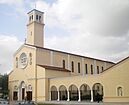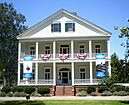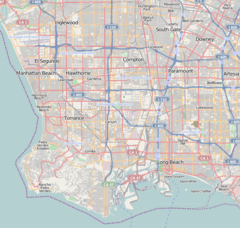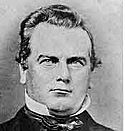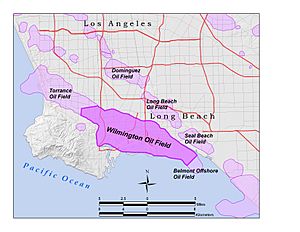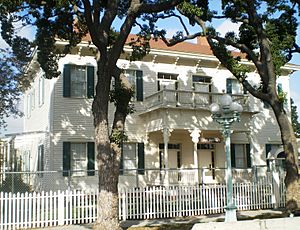Wilmington, Los Angeles facts for kids
Quick facts for kids
Wilmington, Los Angeles
|
|
|---|---|
|
Top: St. Peter & Paul's Church (left) and Banning House (right); bottom: Drum Barracks (left) and Wilmington Municipal Building (right).
|
|
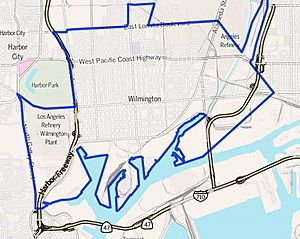
Wilmington as outlined by the Los Angeles Times
|
|
| Country | |
| State | |
| County | |
| City | |
| Named for | Wilmington, Delaware |
| Area | |
| • Total | 9.14 sq mi (23.7 km2) |
| Population | |
| • Total | 53,815 |
| • Density | 5,887/sq mi (2,273/km2) |
| Time zone | Pacific (GMT -08:00) |
| ZIP code |
90744
|
| Area code(s) | 310/424, 323, 562 |
Wilmington is a neighborhood in the South Bay and Harbor region of Los Angeles, California. It covers about 9.14 square miles.
This area is known for its many industries. It has the third-largest oil field in the continental United States. A large part of Wilmington's land is used for oil refineries. This is much more space than is used for parks and green areas.
Wilmington is home to Banning High School. It also has ten other schools for younger students. The neighborhood has six parks where people can relax and play.
Wilmington's history goes back to 1784. That's when Spain gave a large piece of land to a soldier. It became its own city in 1863. Later, in 1909, it joined the city of Los Angeles. Important places here include the Drum Barracks. This was a U.S. Army base built to protect the Los Angeles harbor. It was used during the American Civil War.
Contents
Where is Wilmington Located?
Wilmington is located in Southern California. It shares borders with several other places. To the north is Carson. To the east is Long Beach. San Pedro is to the south and west. Finally, Harbor City is to the northwest.
Who Lives in Wilmington?
About 53,815 people lived in Wilmington in 2010. This means there were about 5,887 people per square mile. The average age of residents was 28 years old. Many people from birth to age 34 live here.
Wilmington has a large Latino community. In 2000, about 86.6% of the people were Latino. Many residents were born outside the U.S. The most common birthplaces were Mexico and Guatemala.
The average household income in 2008 was about $40,627. Most people in Wilmington rent their homes. About 61.5% of homes were rented.
Wilmington's Past: A Look at History
The land where Wilmington now stands was first home to the Tongva people. They are a group of Native Americans. Evidence shows people lived here as far back as 7,100 years ago.
The Spanish Empire arrived in this area in 1542. In 1784, the King of Spain gave a huge piece of land to Juan José Domínguez. This land was called Rancho San Pedro.
Later, in 1858, a man named Phineas Banning bought some of this land. He wanted to build a harbor for Los Angeles. He first called it New San Pedro. In 1863, he renamed it Wilmington. He chose this name after his hometown, Wilmington, Delaware. Banning is often called the "Father of the Harbor."
In 1861, during the American Civil War, Banning helped the government. He gave 60 acres of land to build Drum Barracks. This military base helped protect the harbor from attacks.
Wilmington was a small town in the 1870s. It included parts of what are now Compton and Long Beach. In 1870, about 942 people lived there.
In 1874, Wilson College opened in Wilmington. It was the first college west of the Mississippi River to allow both male and female students. This college later became the University of Southern California.
Los Angeles officially took over Wilmington in 1909. Wilmington and nearby San Pedro now form a large port. This port is one of the biggest in the world for trade. When Wilmington joined Los Angeles, people worried about their city. Los Angeles promised to invest a lot of money in the port and in public projects in Wilmington.
In the 1920s, William Wrigley Jr. built special homes in Wilmington. They were called the "Court of Nations."
The Wilmington Oil Field was found in 1932. It is the third largest oil field in the continental United States. Because of this, there are many oil refineries in the Wilmington area. Some of them have been there since the oil was first discovered.
During World War II, the U.S. Military used the Los Angeles Port of Embarkation in Wilmington. Soldiers and sailors left from here to go to war zones. The California Shipbuilding Corporation also operated in Wilmington. They built many ships during the war.
Fun Places to Visit in Wilmington
- Drum Barracks Civil War Museum – This was once the U.S. Army's main office for Southern California during the Civil War. You can learn about history here.
- The bright green "THE DON" sign – This old neon sign sits on top of a brick building. It used to welcome visitors to the city.
- The first Der Wienerschnitzel restaurant – If you like hot dogs, you can visit the very first Der Wienerschnitzel restaurant here. It's on Pacific Coast Highway.
- The Phillips 66 refinery's giant jack-o'-lantern – Every Halloween, a huge storage tank at the Phillips 66 refinery is decorated like a jack-o'-lantern. It's called the "world's largest jack-o'-lantern." Many people visit it each year.
- The Banning Museum – This museum is in a 23-room house built in 1864. It was the home of Phineas Banning. He was the founder of Wilmington and helped create the Port of Los Angeles.
Learning and Schools in Wilmington
Wilmington is part of the Los Angeles Unified School District. Only a small number of adults in Wilmington have a four-year college degree. However, Wilmington is home to Harbor Teacher Preparation Academy. This school is ranked as one of the best high schools in Los Angeles.
Schools in the Area
Los Angeles Harbor College is a college located in Wilmington. You can find it at 1111 Figueroa Place.
Here are some of the schools in Wilmington:
- Phineas Banning Senior High School, 1527 Lakme Avenue
- Avalon High School, 1425 North Avalon Boulevard
- Pacific Harbor Christian School (private, K-12), 1530 Wilmington Boulevard
- Broad Avenue Elementary School, 24815 Broad Avenue
- Wilmington Christian School (private), 24910 South Avalon Boulevard
- Wilmington Middle School, 1700 Gulf Avenue
- Fries Avenue Elementary School, 1301 Fries Avenue
- Gulf Avenue Elementary School, 828 West L Street
- Wilmington Park Elementary School, 1140 Mahar Avenue
- St. Peter and St. Paul Elementary School (private), 706 Bay View Avenue
- Hawaiian Avenue Elementary School, 540 Hawaiian Avenue
- Harry Bridges Span School, 1235 Broad Avenue
- George De La Torre Jr. Elementary School, 500 Island Avenue
- Harbor Teacher Preparation Academy, 1111 Figueroa Place
Libraries for Reading
The Los Angeles Public Library has a branch in Wilmington. It is called the Wilmington Branch.
Parks and Recreation
Wilmington has several parks and recreation centers for fun activities:
- Banning Recreation Center: This park has an auditorium, baseball fields, basketball courts, and a children's play area. It also has picnic tables and tennis courts.
- East Wilmington Greenbelt Community Center: This center offers indoor basketball courts, classrooms, and after-school programs.
- East Wilmington Greenbelt Pocket Park: A smaller park located at 1300 East O Street.
- Wilmington Recreation Center: Features an auditorium, baseball fields, basketball courts, and a children's play area. It has community rooms and picnic areas.
- Wilmington Senior Citizen Center: This center has an auditorium, baseball fields, basketball courts, and a children's play area. It also has an indoor gym and tennis courts.
- The Wilmington Waterfront Park: This park opened in June 2011. It is located near the Port of Los Angeles.
Famous People from Wilmington
Many interesting people have connections to Wilmington, including:
- John Avalos (born 1964), a member of the San Francisco Board of Supervisors.
- Wilder W. Hartley (1901–1970), who served on the Los Angeles City Council.
- Asa Keyes (1877–1934), a district attorney for Los Angeles County.
- Eric Plunk (born 1963), a former professional baseball pitcher.
- Thuy Trang (1973–2001), an actress.
- Charmian London (1871-1955), a writer and wife of famous author Jack London.
Images for kids


